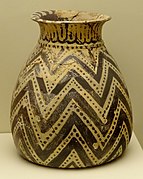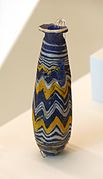Alabastron
As Alabastron ( ancient Greek ἀλάβαστρον , ancient Greek ἀλάβαστρος or ancient Greek ἀλάβαστον ; plural Alabastra ancient Greek ἀλάβαστρα ) is referred to in the archeology an antique or pear-shaped slim vessel in the form of a vial without base and handle with a rounded bottom. Sometimes they had two or more eyelets to which they could be attached with the help of threads. Alabastra were used to store oils, ointments, fragrances and precious, aromatic essences. They were mainly used by women, while men used the aryballos as an ointment vessel.
development
Originally the alabastras in Egypt were made from alabaster and filled with oils, ointments and perfumes were exported to the entire Mediterranean region. Therefore it was assumed that the name of the vessel was derived from this stone. Another attempt to explain it says that the name comes from the Greek alaba ( ancient Greek ἀλάβα ) which means "without a handle". This is supported by the indication in the Suda , which describes the alabastron as an ointment vessel without a handle.
The oldest vessels in the shape of an alabastron come from the cosmetics box of the Egyptian Queen Mentuhotep , who was probably built in the 17th century BC. Lived. The first alabastras that can be dated more precisely are inscribed with the names of the pharaohs Osorkon II (881 / 0–852 / 1 BC) and Takelot II (842 / 1–816 / 5). They were bulbous and still had a short neck. In al-Kurru , more alabastra were found in the graves of the wives of Pharaoh Pije (746–716 BC). Such vessels were also found in the 8th and 7th centuries BC. Outside of Egypt. Alabastras were very common during the 26th Dynasty . An alabastra workshop that was excavated in Naukratis dates from this time . Alabastras that were not made in Egypt appeared in the 6th and 5th centuries.
Already in the 7th century BC In Mesopotamia the production of alabastra from glass began. In Greece , tonalabastra with a pointed bottom was made around the same time, and in Etruria Alabastra from Bucchero with a round bottom. The manufacture of alabastra from glass and ceramics now spread across the entire Mediterranean. Specimens were also made from other types of rock, silver and gold. To keep the alabastra there was a box called the alabastrotheke ( ancient Greek ἀλαβαστροθήκη or ancient Greek ἀλαβαστοθήκη ).
Minoan and Mycenaean alabastra
Minoan and Mycenaean alabastra are bulbous clay vessels with a flat bottom. Wider vessels are called squeezed , flat as squeezed-flat, and with straight sides as cylindrical alabastra. Alabastra were found, for example, in the necropolises of Knossos and Phaistos in Crete ; they date from around 1900 to 1300 BC. They are decorated in the palace style with depictions of birds, fish and octopus.
In the Orthodox churches the glass or metal vessel that contains the myron is still called an alabastron.
gallery
Minoan alabastron from Mochlos
Mycenaean pressed alabastron from Rhodes
Mycenaean pressed-flat alabastron from Attica
See also
Web links
August Mau : Alabastron . In: Paulys Realencyclopadie der classischen Antiquity Science (RE). Volume I, 1, Stuttgart 1893, Col. 1272 f.
literature
- Günther Hölbl : Relations between Egyptian culture and ancient Italy, Part 1, Leiden 1979, pp. 240–253
- William Smith : Alabastrum in William Smith: Dictionary of Greek and Roman Antiquities , 1890 ( online )







